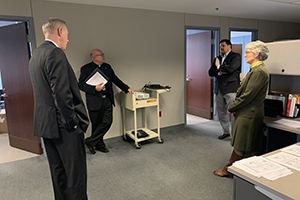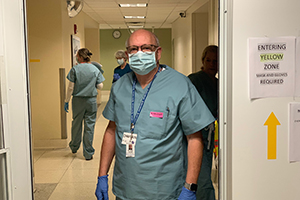Rising to the call
May 14, 2020
When Buffalo, New York-based Catholic Health converted one of its five hospital campuses into a dedicated COVID-19 treatment facility March 26, leadership knew from the outset they'd need a strong spiritual care staff presence to help clinicians, other associates, patients and families to handle the toll the pandemic is taking on them.
The health system recruited Fr. John Gaglione out of retirement to become the director of pastoral care for the Catholic Health COVID-19 Treatment Facility at St. Joseph Campus, a site that can surge to 188 beds. To set up and maintain a robust set of spiritual care services amid a pandemic, Fr. Gaglione has drawn upon his background as a diocesan priest, a mission department executive with Catholic Health and a disaster preparedness expert for the city of Buffalo.
He spoke to Catholic Health World's Julie Minda in mid-April about tending to the spiritual needs of staff, patients and family members amid crisis conditions.
When we established the spiritual care presence at the facility, we certainly looked at what was needed for caring for patients and families, but a priority was how we care for our caregivers — our staff. We have four chaplains and myself providing on-site or on-call coverage, and between the five of us we provide 24-7 coverage.

Fr. Gaglione, second from left, meets with leadership of Catholic Health. From left are Mark Sullivan, president and chief executive; Marty Boryszak, senior vice president of acute care service; and Rebecca McCormick-Boyle, chief integration officer.
The hospital has a red zone, where we have patients who have COVID and those recovering; the yellow zone where spiritual care staff and clinicians take off personal protective gear after contact with patients; and the green zone, where all staff can go for a break. I and the other chaplains go into all the zones. We visit with patients who are conscious — we make rounds and seek out patients. We are present to staff. And we stay in touch with patients' families.

Fr. John Gaglione directs pastoral care for the Catholic Health COVID-19 Treatment Facility at St. Joseph Campus in Buffalo, New York. The site has three zones for contagion control: the restricted access red zone where staff are required to wear personal protective gear, the yellow zone where they remove their PPE, and the green zone, which is open to all staff.
Nurses are asking patients' families upon intake whether they want to speak with a chaplain. We follow up with those loved ones who want to talk to a chaplain. And we make all death notifications — we call those families. We send a sympathy card home to the families, saying we're lighting a candle in our chapel in memory of their loved one. We have an electronic candle lit for each deceased patient.
The chaplains who serve here were brought in from all different Catholic Health facilities, and while we're all used to dealing with very sick patients, and with death notifications, here it's every day that we're doing this, unlike in usual times. And it's difficult because, unlike in usual times, the families can't be here when their loved ones are dying. This is different for us, and we're doing all of this by phone and videoconferencing, unlike usual.
When it comes to the staff, when we first started up the facility, there was a sense of apprehension, especially among those who are not used to dealing with so many patients who are very sick like these patients are. And many of us chaplains felt the same way — apprehensive. But that has eased a bit for us and the staff and there is not as much apprehension because we are feeling safer. But, it's still really difficult because hospital staff are not used to seeing so many very sick and dying patients and being in such close quarters. There is a mood now that we are tired but committed.
To help these staff, we're providing a ministry of presence. We're there to say a prayer with them, to let them know we care and are available to them if they want to talk. The main thing is that we're talking with them, asking how they are doing, asking if they are taking breaks. We reassure them we are praying for them — they are the healing hands of Jesus.
Our chapel is open so staff can go in and pray.
Being here is sobering but wonderful because there are tremendous, faith-filled people working here, and all of them are important — from the cafeteria worker to the cleaning crew to the nurses. They are all part of the link and if that link is broken, it affects patient care. As we support them, we see their tremendous dedication and the risk they are taking. Some are working 14-hour days.
In this facility we're dealing with the sickest of the sick. Many here are on respirators and can't speak. But many of the patients we chaplains talk to are the ones who are getting better and are well enough to be able to talk. Those patients are so thankful to be getting better, and they're looking forward to going home. When those who have been treated successfully are discharged, we play music on the intercom, and staff gather around the patient and clap and congratulate the patient. We're hearing the music played quite a bit lately, and that makes each day better.